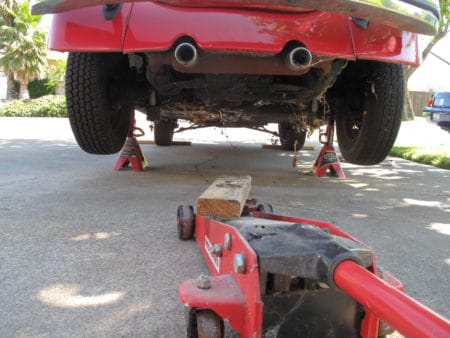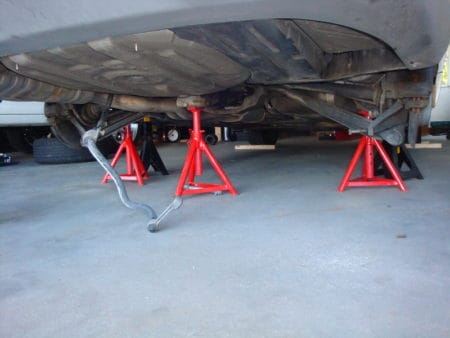Whether putting your car up at home, or doing your work at the track, you’ll need some tools. I’m one to over-prepare like crazy, so I had a friend take a second car (a full-size SUV), crammed to the top with tons of tools and spares. Having all of these tools was a bit of a pain, but I’m honestly glad I took them. Had something happened, and I didn’t have those tools, I would’ve been borked. In hindsight, I could’ve done with fewer tools, however. These are the essentials, the tools I know I’d never go drifting without.
(NOTE: Images aren’t of actual products, just of similar ones. Thanks, Amazon! lol)
Low-Profile, Long-Reach Jack
 Picture this: You’re at the drift track, and trying to swap a tire you just blew out. You’ve got the spare tire, your impact gun (we’ll talk about this later), and your floor jack with you. You go to try and lift the car.. The jack won’t fit. Your car is too low for your jack to get under! I made this mistake once, and I’ll never do that again. Bringing the right tools for your car is vital, and having a slammed S14, a regular floor jack definitely wasn’t the right tool.
Picture this: You’re at the drift track, and trying to swap a tire you just blew out. You’ve got the spare tire, your impact gun (we’ll talk about this later), and your floor jack with you. You go to try and lift the car.. The jack won’t fit. Your car is too low for your jack to get under! I made this mistake once, and I’ll never do that again. Bringing the right tools for your car is vital, and having a slammed S14, a regular floor jack definitely wasn’t the right tool.
The front and rear bumpers on that car were so low that I couldn’t fit my floor jack under. I had to limp the car, with a blown tire, onto some blocks of wood. This raised my rear bumper so I could get my jack under it. Sliding my jack under the now-lifted car, I was able to lift it up, and swap out the tires successfully. Had I realized my jack wouldn’t fit under the car before the event, I’d have gotten a low-profile jack earlier.
Why This Jack?
This is one of the most important tools to have while working on a car. It has a low minimum height of 3″, quick-pump handle, and 3-ton lift capacity (which is more than enough for any drift car, 3 tons is 6000 lbs). These help you get under the car, lift it quickly, and support it for sure. All of these combined help you spend less time on the sidelines, and more behind the wheel.
Having those wide front wheels helps when you’re working on your car in unfavorable terrain, too. With higher wheel surface area, mixed with the flat bottom of the jack, you’ll be able to lift your car even on gravel or dirt. I personally wouldn’t recommend attempting to lift on dirt/gravel, but if need be, this jack could do it.
Jack Stands
 Having a jack to lift your car is important, but you always have the risk of your car falling off the jack :0 . Removing this risk is easy! That’s why we invented jack stands! These nifty little buggers allow you to keep your car up, and lift more than one part of your car with the jack! The most important use of the stands is to avoid any risk of your car falling on you, or the ground, while you’re working on it.
Having a jack to lift your car is important, but you always have the risk of your car falling off the jack :0 . Removing this risk is easy! That’s why we invented jack stands! These nifty little buggers allow you to keep your car up, and lift more than one part of your car with the jack! The most important use of the stands is to avoid any risk of your car falling on you, or the ground, while you’re working on it.
While you’re working on uneven or gravel-y surfaces, a jack alone isn’t enough to keep you stable while working. Bringing along some stands helps with that issue greatly. These stands come in three varieties, 2-ton, 3-ton, and 6-ton options. The 2-ton stands should be plenty, as combined, they give 4000 lbs of carrying capacity, which is more than enough for most drift cars. These stands also feature a “double-locking” mechanism, for a much more reliable reinforcement.
Impact Gun
Making repairs at home, or swapping wheels at the track, turning wrenches isn’t much fun. Especially when you’re working on a rusted car, straining to break bolts loose is a pain. Having an impact gun really helps with both situations. The air version can be a lot more powerful, however, you’re limited in using it, as you need a powerful air compressor to keep up. A corded one is okay, however, you’re limited in use there as well. In my experience, the torque this battery one provides is plenty for any stuck bolt or lug nuts. Sometimes, it can even be too much torque. The pressure-sensitive trigger helps with that problem, though, allowing you to deliver just part of the power.
Make sure that you have a set of sockets that will fit your impact gun as well. They need to be actual impact sockets, as normal sockets will shatter if exposed to such force. If you don’t already have some, I suggest this kit: https://www.amazon.com/Neiko-02446A-2-Inch-Accessories-35-Piece/dp/B07F6Y7VRC. This includes a full metric socket seat, a full SAE set, a ratchet, three size adapters, four extensions, a carrying case, and a partridge in a pear tree. This makes for a versatile kit that is easy to carry and contains every bolt removal tool you’ll feasibly need.
Torque Wrench (Beam/Clicker)
Having the tools to take something apart is important, but you can’t do everything with the impact gun! You’d over-tighten all your bolts, and probably snap the heads off quite a few. What’s worse, if you have fragile or aluminum rims, you could crack or gouge them if you aren’t careful while tightening your lugs! All parts on your car are going to have a “torque spec”, or a pressure to which you should tighten your bolts. If you’ve been a machinist for 30 years, you might be able to get close by hand. However, most of us haven’t had that experience, so we have to make do with these torque wrenches.
Depending on your preferences, there are two main types of torque wrenches. The first is called a “Beam-Style”. This uses a main handle for you to grip on, and when you pull against a nut, there’s a little flex in your handle. There’s a beam that’s attached solely to the head of the wrench, and that stretches down to just above the handle. There’s a gauge there, that the beam points to, that shows you how much torque you’re applying. That number should match up with the “ft-lbs” rating that you found in your owners manual or online. You may need a smaller torque wrench if you’re dealing in “in-lbs” (foot-pounds and inch-pounds respectively).
The second style is called a “Clicker-Style”. This one has a screwing handle that allows you to set the torque rating you’re trying to tighten to. Then, just go about using it like a normal breaker bar. Once you’ve hit the torque you set with the handle, the head goes “Click”. It’ll let loose for a split second when it does this, and that’s your sign to quit tightening. No looking at gauges needed!
The Most Important Resources To Have While Drifting
 Now, while dog may be man’s best friend, these things are a drifter’s best friend. Duct Tape and Zip Strips! No, I’m not kidding. Why are you laughing!? This is a real thing, I promise! Zip Strips are a big part of repairing drift cars with a method known as the “drift stitch”. When you run into something (or someone) while drifting, and you will for sure, you might crack some bumpers. Using a drill and some zip strips, you can hold that bumper together quite nicely, and add some character to your ride too!
Now, while dog may be man’s best friend, these things are a drifter’s best friend. Duct Tape and Zip Strips! No, I’m not kidding. Why are you laughing!? This is a real thing, I promise! Zip Strips are a big part of repairing drift cars with a method known as the “drift stitch”. When you run into something (or someone) while drifting, and you will for sure, you might crack some bumpers. Using a drill and some zip strips, you can hold that bumper together quite nicely, and add some character to your ride too!
As far as the duct tape goes, when entire panels are starting to fall off, you’d need a lot of stitches to keep it attached, ruining the panel. Just use duct tape all around it, hold it together for the day, and properly re-mount it after the event. That, or you could just remove the panel entirely, and haul it home and remount it there.

